Panasonic TH-70LF50 Operation Manual

Model No.
TH-70LF50U
TH-80LF50U
Operating Instructions
FULL HD LCD Display
English |
Before connecting, operating or adjusting this product, |
|
|
|
|
|
|
||
please read these instructions completely. |
|
|
|
|
|
Please keep this manual for future reference. |
|
|
|
|
|
|
|
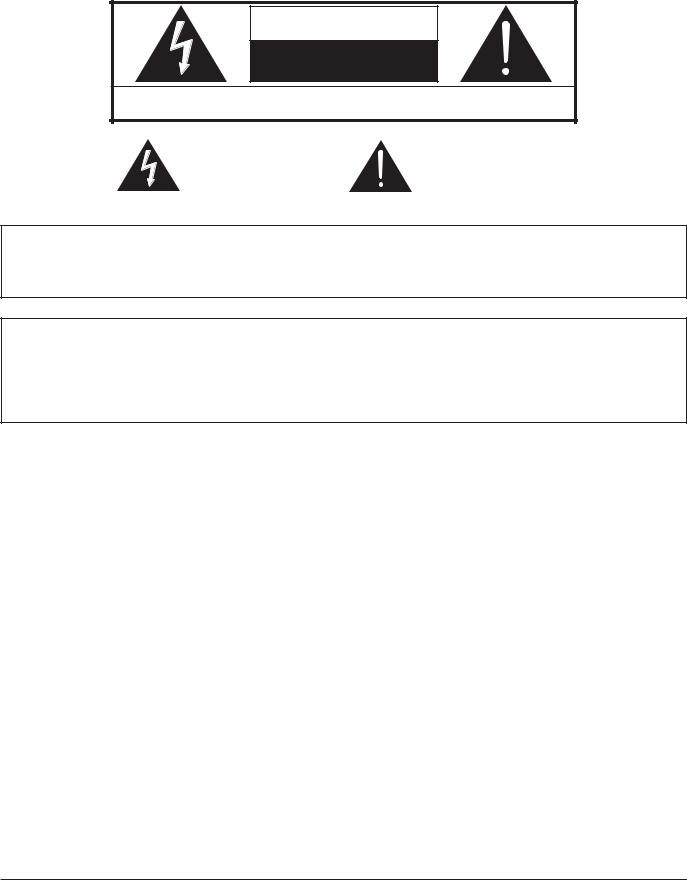
CAUTION
RISK OF ELECTRIC SHOCK
DO NOT OPEN
WARNING: To reduce the risk of electric shock, do not remove cover or back. No user-serviceable parts inside. Refer servicing to qualied service personnel.
The lightning flash with arrow-head within a triangle is intended to tell the user that parts inside the product are a risk of electric shock to persons.
The exclamation point within a triangle is intended to tell the user that important operating and servicing instructions are in the papers with the appliance.
WARNING : To prevent damage which may result in re or shock hazard, do not expose this apparatus to rain or moisture.
Do not place containers with water (ower vase, cups, cosmetics, etc.) above the set. (including on shelves above, etc.)
WARNING : 1) To prevent electric shock, do not remove cover. No user serviceable parts inside. Refer servicing to quali ed service personnel.
2)Do not remove the grounding pin on the power plug. This apparatus is equipped with a three pin grounding-type power plug. This plug will only t a grounding-type power outlet. This is a safety feature. If you are unable to insert the plug into the outlet, contact an electrician.
Do not defeat the purpose of the grounding plug.
2

Important Safety Instructions
1)Read these instructions.
2)Keep these instructions.
3)Heed all warnings.
4)Follow all instructions.
5)Do not use this apparatus near water.
6)Clean only with dry cloth.
7)Do not block any ventilation openings. Install in accordance with the manufacturer’s instructions.
8)Do not install near any heat sources such as radiators, heat registers, stoves, or other apparatus (including ampli ers) that produce heat.
9)Do not defeat the safety purpose of the polarized or grounding-type plug. A polarized plug has two blades with one wider than the other. A grounding type plug has two blades and a third grounding prong. The wide blade or the third prong are provided for your safety. If the provided plug does not t into your outlet, consult an electrician for replacement of the obsolete outlet.
10)Protect the power cord from being walked on or pinched particularly at plugs, convenience receptacles, and the point where they exit from the apparatus.
11)Only use attachments / accessories speci ed by the manufacturer.
12)Use only with the cart, stand, tripod, bracket, or table speci ed by the manufacturer, or sold with
the apparatus. When a cart is used, use caution when moving the cart / apparatus combination to avoid injury from tip-over.
13) Unplug this apparatus during lightning storms or when unused for long periods of time.
14) Refer all servicing to quali ed service personnel. Servicing is required when the apparatus has been damaged in any way, such as power-supply cord or plug is damaged, liquid has been spilled or objects have fallen into the apparatus, the apparatus has been exposed to rain or moisture, does not operate normally, or has been dropped.
15) To prevent electric shock, ensure the grounding pin on the AC cord power plug is securely connected.
3
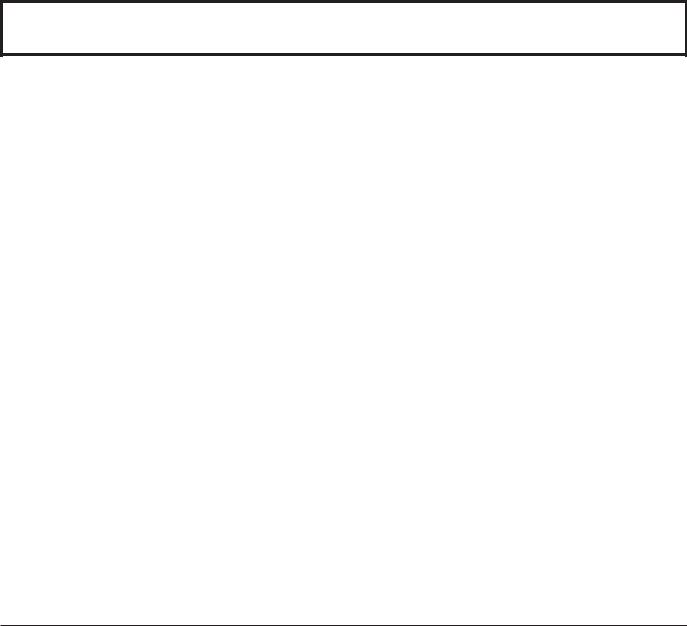
Dear Panasonic Customer
Welcome to the Panasonic family of customers. We hope that you will have many years of enjoyment from your new LCD Display.
To obtain maximum benefit from your set, please read these Instructions before making any adjustments, and retain them for future reference.
Retain your purchase receipt as well, and record the model number and serial number of your set in the space provided on the rear cover of these instructions.
Visit our Panasonic Web Site |
http://panasonic.net |
Table of Contents
Important Safety Instructions.................................. |
3 |
FCC STATEMENT...................................................... |
5 |
Safety Precautions ................................................... |
6 |
Maintenance.............................................................. |
7 |
Accessories .............................................................. |
8 |
Accessories Supplied.............................................. |
8 |
Remote Control Batteries ........................................ |
8 |
Ceiling Suspension .................................................. |
9 |
Connections............................................................ |
10 |
AC cord connection and xing............................... |
10 |
Video equipment connection .................................. |
11 |
AUDIO OUT connection ......................................... |
11 |
VIDEO, COMPONENT / RGB IN and HDMI connection ... |
12 |
DVI-D IN, DVI-D OUT connection ......................... |
13 |
PC Input Terminals connection.............................. |
14 |
SERIAL Terminals connection............................... |
15 |
Power ON / OFF ...................................................... |
17 |
Selecting the input signal...................................... |
19 |
Basic Controls ........................................................ |
20 |
ASPECT Controls ................................................... |
22 |
Digital Zoom............................................................ |
23 |
On-Screen Menu Displays ..................................... |
24 |
Adjusting POS. /SIZE ............................................. |
25 |
PICTURE Adjustments ........................................... |
27 |
ADVANCED SETTINGS........................................ |
28 |
SOUND Adjustment................................................ |
29 |
SDI SOUND OUTPUT........................................... |
29 |
PRESENT TIME SETUP / SET UP TIMER.............. |
30 |
PRESENT TIME SETUP....................................... |
30 |
SET UP TIMER ..................................................... |
31 |
SCREENSAVER (For preventing image retention)... |
32 |
Setup of SCREENSAVER Time ............................ |
33 |
WOBBLING.............................................................. |
33 |
NO ACTIVITY POWER OFF .................................... |
34 |
ECO MODE SETTINGS........................................... |
35 |
Customizing the Input labels................................. |
36 |
Selecting the On-Screen Menu Language............ |
37 |
Customizing the On-Screen Menu Display .......... |
37 |
SET UP for MULTI DISPLAY................................... |
38 |
How to setup MULTI DISPLAY.............................. |
38 |
ID Remote Control Function.................................. |
39 |
SET UP for Input Signals ....................................... |
40 |
COMPONENT / RGB IN SELECT......................... |
40 |
YUV / RGB IN SELECT......................................... |
40 |
SIGNAL menu ....................................................... |
41 |
3D Y/C FILTER...................................................... |
41 |
COLOR SYSTEM.................................................. |
42 |
3:2 PULLDOWN .................................................... |
42 |
XGA MODE ........................................................... |
42 |
NOISE REDUCTION............................................. |
43 |
SYNC .................................................................... |
43 |
HDMI RANGE ....................................................... |
43 |
Input signal display................................................ |
44 |
Network Setup ........................................................ |
45 |
Options Adjustments ............................................. |
46 |
Input Search.......................................................... |
48 |
Using Network Function ........................................ |
49 |
Example of Network Connection........................... |
49 |
Command Control ................................................. |
49 |
PJLink™ Protocol.................................................. |
50 |
Using Web Browser Control.................................. |
51 |
Before Using Web Browser Control....................... |
51 |
Access from Web Browser .................................... |
51 |
Display Control (BASIC CONTROL/OPTION CONTROL Screen) ... |
52 |
NETWORK SETTING (Network Setup Screen) .... |
53 |
Password Setting (Password Setup Screen) ........ |
53 |
Troubleshooting ..................................................... |
54 |
Applicable input signals ........................................ |
55 |
Shipping condition................................................. |
57 |
Specications ......................................................... |
58 |
4

FCC STATEMENT
This equipment has been tested and found to comply with the limits for a Class B digital device, pursuant to Part 15 of the FCC Rules. These limits are designed to provide reasonable protection against harmful interference in a residential installation. This equipment generates, uses and can radiate radio frequency energy and, if not installed and used in accordance with the instructions, may cause harmful interference to radio communications. However, there is no guarantee that interference will not occur in a particular installation. If this equipment does cause harmful interference to radio or television reception, which can be determined by turning the equipment off and on, the user is encouraged to try to correct the interference by one or more of the following measures:
•Reorient or relocate the receiving antenna.
•Increase the separation between the equipment and receiver.
•Connect the equipment into an outlet on a circuit different from that to which the receiver is connected.
•Consult the dealer or an experienced technician for help.
This device complies with Part15 of the FCC Rules. Operation is subject to the following two conditions:(1) This device may not cause harmful interference, and (2) this device must accept any interference received, including interference that may cause undesired operation.
FCC CAUTION:
To assure continued compliance, follow the attached installation instructions and use only shielded interface cables when connecting to computer or peripheral devices. Any changes or modications not expressly approved by Panasonic Corp. of North America could void the user's authority to operate this device.
FCC Declaration of Conformity
Model No. TH-70LF50U, TH-80LF50U
Responsible Party: |
Panasonic Corporation of North America |
|
Three Panasonic Way 2F-5, Secaucus, NJ 07094 |
Contact Source: |
Panasonic System Communications Company of North America |
|
1-885-772-8324 |
CANADIAN NOTICE:
This Class B digital apparatus complies with Canadian ICES-003.
Note:
Image retention may occur. If you display a still picture for an extended period, the image might remain on the screen. However, it will disappear after a while.
Trademark Credits
•VGA is a trademark of International Business Machines Corporation.
•Macintosh is a registered trademark of Apple Inc., USA.
•SVGA, XGA, SXGA and UXGA are registered trademarks of the Video Electronics Standard Association.
Even if no special notation has been made of company or product trademarks, these trademarks have been fully respected.
•HDMI, the HDMI Logo, and High-De nition Multimedia Interface are trademarks or registered trademarks of HDMI Licensing LLC in the United States and other countries.
5

Safety Precautions
CAUTION
This LCD Display is for use only with the following optional accessories. Use with any other type of optional accessories may cause instability which could result in the possibility of injury.
(All of the following accessories are manufactured by Panasonic Corporation.)
• Pedestal ................................................... |
TY-ST58P20 (for TH-70LF50U) |
|
TY-ST65P20 (for TH-80LF50U) |
• Wall-hanging bracket (vertical) ................ |
TY-WK70PV50 |
• HD-SDI Terminal Board with audio .......... |
TY-FB10HD |
• Protective Glass ...................................... |
TY-PG70LF50 (for TH-70LF50U) |
|
TY-PG80LF50 (for TH-80LF50U) |
Always be sure to ask a quali ed technician to carry out set-up.
Small parts can present choking hazard if accidentally swallowed. Keep small parts away from young children. Discard unneeded small parts and other objects, including packaging materials and plastic bags/sheets to prevent them from being played with by young children, creating the potential risk of suffocation.
 When using the LCD Display
When using the LCD Display
Do not bring your hands, face or objects close to the ventilation holes of the Display.
•Top of the Display is usually very hot due to the high temperature of exhaust air being released through the ventilation holes. Burns or personal injuries can happen if any body parts are brought too close. Placing any object near the top of the display could also result in heat damages to the object as well as to the Display if its ventilation holes are blocked.
Be sure to disconnect all cables before moving the Display.
•Moving the Display with its cables attached might damage the cables which, in turn, can cause re or electric shock.
Disconnect the power plug from the wall outlet as a safety precaution before carrying out any cleaning.
• Electric shocks can result if this is not done.
Clean the power cable regularly to prevent it from becoming dusty.
•Built-up dust on the power cord plug can increase humidity which might damage the insulation and cause re. Unplug the cord from the wall outlet and clean it with a dry cloth.
Note:
Image retention may occur. If you display a still picture for an extendedperiod,theimagemightremainonthescreen.However, it will disappear after a while.
6

Safety Precautions
WARNING
 Setup
Setup
Do not place the Display on sloped or unstable surfaces, and ensure that the Display does not hang over the edge of the base.
• The Display may fall off or tip over.
Do not place any objects on top of the Display.
•If water spills onto the Display or foreign objects get inside it, a short-circuit may occur which could result inre or electric shock. If any foreign objects get inside the Display, please consult an Authorized Service Center.
Do not cover the ventilation holes.
•Doing so may cause the Display to overheat, which can cause re or damage to the Display.
Transport only in upright position!
•Transporting the unit with its display panel facing upright or downward may cause damage to the internal circuitry.
For sufcient ventilation;
Leave a space of 3 15/16” (10 cm) or more at the top, left and right, and 2 3/4” (7 cm) or more at the rear, and also keep the space between the bottom of the display and the oor surface.
Cautions for Wall Installation
•Wall installation should be performed by an installation professional. Installing the Display incorrectly may lead to an accident that results in death or serious injury. Use the speci ed optional accessories.
•When installing the Display vertically, be sure to install the power indicator onto the top of the Display.
Caution for Ceiling Suspension
•Ceiling suspension should be performed by an installation professional. Installing the Display incorrectly may lead to an accident that results in death or serious injury.
An apparatus with CLASS I construction shall be connected to a mains socket outlet with a protective earthing connection.
Do not install the product to a place where the product is exposed to direct sunlight.
•If the screen is exposed to direct sunlight, the liquid crystal panel may have adverse effect.
 AC Power Supply Cord
AC Power Supply Cord
The Display is designed to operate on 110 - 127 V AC, 50/60 Hz.
Ensure that the mains plug is easily accessible.
Do not use any power supply cord other than that provided with this unit.
• Doing so may cause re or electric shocks.
Securely insert the power cord plug as far as it will go.
•If the plug is not fully inserted, heat may be generated which could cause re. If the plug is damaged or the wall socket plate is loose, they should not be used.
Do not handle the power cord plug with wet hands.
• Doing so may cause electric shocks.
Do not do anything that might damage the power cable. When disconnecting the power cable, hold the plug, not the cable.
•Do not make any modi cations, place heavy objects on, place near hot objects, heat, bend, twist or forcefully pull the power cable. Doing so may cause damage to the power cable which can cause re or electric shock. If damage to the cable is suspected, have it repaired at an Authorized Service Center.
If the Display will not be used for a long period of time, unplug the power cord from the wall outlet.
 If problems occur during use
If problems occur during use
If a problem occurs (such as no picture or no sound), or if smoke or an abnormal odor is detected from the Display, unplug the power cord immediately.
•Continuous use of the Display under these conditions might cause re or permanent damage to the unit. Have the Display evaluated at an Authorized Service Center. Services to the Display by any unauthorized personnel are strongly discouraged due to its high voltage dangerous nature.
If water or foreign objects get inside the Display, if the Display is dropped, or if the cabinet becomes damaged, disconnect the power cord plug immediately.
•A short may occur, which could cause re. Contact an Authorized Service Center for any repairs that need to be made.
Maintenance
The front of the display panel has been specially treated. Wipe the panel surface gently using only a cleaning cloth or a soft, lint-free cloth.
•If the surface is particularly dirty, wipe with a soft, lint-free cloth which has been soaked in pure water or water in which neutral detergent has been diluted 100 times, and then wipe it evenly with a dry cloth of the same type until the surface is dry.
•Do not scratch or hit the surface of the panel with ngernails or other hard objects, otherwise the surface may become damaged. Furthermore, avoid contact with volatile substances such as insect sprays, solvents and thinner, otherwise the quality of the surface may be adversely affected.
If the cabinet becomes dirty, wipe it with a soft, dry cloth.
•If the cabinet is particularly dirty, soak the cloth in water to which a small amount of neutral detergent has been added and then wring the cloth dry. Use this cloth to wipe the cabinet, and then wipe it dry with a dry cloth.
•Do not allow any detergent to come into direct contact with the surface of the Display. If water droplets get inside the unit, operating problems may result.
•Avoid contact with volatile substances such as insect sprays, solvents and thinner, otherwise the quality of the cabinet surface may be adversely affected or the coating may peel off. Furthermore, do not leave it for long periods in contact with articles made from rubber or PVC.
Usage of a chemical cloth
•Do not use a chemical cloth for the panel surface.
•Follow the instructions for the chemical cloth to use it for the cabinet.
7
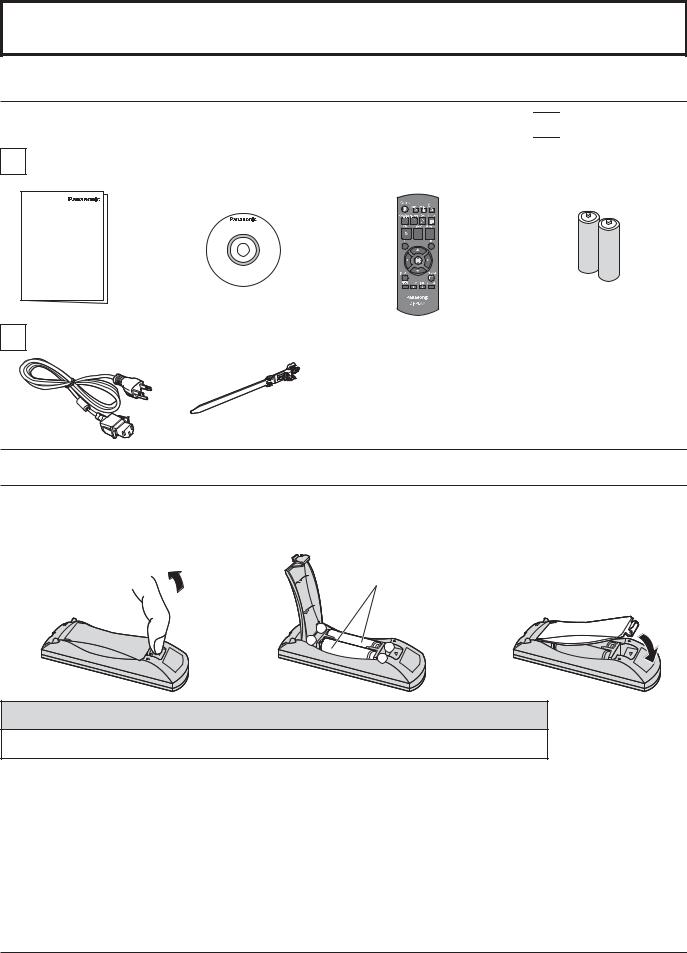
Accessories
Accessories Supplied
Check that you have the Accessories and items shown 

Operating |
|
|
CD-ROM |
|
Remote Control Transmitter |
|
Batteries for the |
|||||||||
Instruction book |
|
|
(Operating |
|
N2QAYB000691 |
|
Remote Control |
|||||||||
|
|
|
|
|
|
instructions) |
|
|
|
|
|
|
|
|
Transmitter |
|
|
|
|
|
|
|
|
|
|
|
|
|
|
|
|
|
(AA Size × 2) |
|
|
|
|
|
|
|
|
|
|
|
|
|
|
|
||
|
|
|
|
|
|
|
|
|
|
|
|
|
|
|
|
|
|
|
|
|
|
|
|
|
|
|
|
|
|
|
|
|
|
|
|
|
|
|
|
|
|
|
|
|
|
|
|
|
|
|
|
|
|
|
|
|
|
|
|
|
|
|
|
|
|
|
|
|
|
|
|
|
|
|
|
|
|
|
|
|
|
|
|
|
AC cord |
|
Clamper × 1 |
|
|
TMME289 |
|
|
Remote Control Batteries
Requires two AA batteries.
1.Pull and hold the hook, then open the battery cover.
2. Insert batteries - note correct |
3. Replace the cover. |
polarity (+ and -). |
|
“AA” size |
|
- |
+ |
+ |
|
- |
Helpful Hint:
For frequent remote control users, replace old batteries with Alkaline batteries for longer life.
 Precaution on battery use
Precaution on battery use
Incorrect installation can cause battery leakage and corrosion that will damage the remote control transmitter. Disposal of batteries should be in an environment-friendly manner.
Observe the following precautions:
1.Batteries should always be replaced as a pair. Always use new batteries when replacing the old set.
2.Do not combine a used battery with a new one.
3.Do not mix battery types (example: “Zinc Carbon” with “Alkaline”).
4.Do not attempt to charge, short-circuit, disassemble, heat or burn used batteries.
5.Battery replacement is necessary when the remote control acts sporadically or stops operating the Display.
6.Do not burn or breakup batteries.
Batteries must not be exposed to excessive heat such as sunshine, re or the like.
8

Ceiling Suspension
You can install the Display by attaching commercially available eyebolts (M10) to it and suspending it from the ceiling, etc.
Eyebolt mounting positions (for horizontal installation)
Notes:
• Suspension and installation should be performed by an installation professional.
• Do not install it using only one eyebolt.
• When the Display is installed horizontally, make sure to place the power Indicator side down and, face up the power Indicator side, when it is installed vertically.
• Install the wire along the vertical side when suspending the Display.
Eyebolt mounting positions (for vertical installation)
9

Connections
AC cord connection and xing, cable xing
AC cord xing
Unplug the AC cord
|
|
Unplug the AC cord pressing the |
|
Plug the AC cord into the display unit. |
two knobs. |
|
Plug the AC cord until it clicks. |
Note: |
|
Note: |
When disconnecting theAC cord, be |
|
Make sure that the AC cord is locked on |
absolutely sure to disconnect theAC |
AC cord |
both the left and right sides. |
cord plug at the socket outlet rst. |
(accessory) |
|
|
Using the clamper
Secure any excess cables with clamper as required.
Note:
One clamper is supplied with this unit. In case of securing cables at four positions, please purchase it separately.
TH-70LF50U |
TH-80LF50U |
1 |
Attach the clamper |
To remove from the unit: |
hole
 snaps
snaps
Insert the clamper |
Keep |
|
pushing both |
||
in a hole. |
||
side snaps |
||
|
2 Bundle the cables |
To loosen: |
|
Set the |
|
Keep |
|
|
knob |
pushing |
||
hooks |
tip in the |
|||
the knob |
||||
|
||||
|
hooks |
|
|
10

Connections
Video equipment connection
Ex. TH-80LF50U
SERIAL IN, SERIAL OUT
SERIAL Input/Output Terminal Control the Display by connecting to PC.
(see page 15)
AV IN |
|
DVI-D IN, DVI-D OUT |
|
|
PC IN |
|||||||
HDMI |
|
DVI-D Input/ |
|
|
PC Input |
|||||||
HDMI Input Terminal |
|
Output Terminal |
|
|
Terminal |
|||||||
(see page 12) |
|
(see page 13) |
|
|
(see page 14) |
|||||||
|
|
|
|
|
|
|
|
|
|
|
|
|
|
|
|
|
|
|
|
|
|
|
|
|
|
|
|
|
|
|
|
|
|
|
|
|
|
|
|
|
|
|
|
|
|
|
|
|
|
|
|
AUDIO IN (COMPOSITE)
Connect the audio output of a device connected to VIDEO.
(see page 12)
AUDIO IN (DVI-D / PC)
Connect the audio output of a device connected to DVI-D IN, PC IN.
(see page 13, 14)
|
|
|
|
|
|
|
|
|
|
|
|
|
|
|
|
|
|
|
|
|
|
|
|
|
|
|
|
|
|
|
|
|
|
|
|
|
|
|
|
|
|
|
|
|
|
|
|
|
|
|
|
|
|
|
|
|
|
|
|
|
|
|
|
|
|
|
|
|
|
|
|
|
|
|
|
|
|
|
|
|
|
|
|
|
|
|
|
|
|
|
|
|
|
|
|
|
|
|
|
|
|
|
|
|
|
|
|
|
|
|
|
|
|
|
|
|
|
|
|
|
|
|
|
|
|
|
|
|
|
|
|
|
|
|
|
|
|
|
|
|
|
|
|
|
|
|
|
|
|
|
|
|
|
|
|
|
|
|
|
|
|
|
|
|
|
|
|
|
|
|
|
|
|
|
|
|
|
|
|
|
|
|
|
|
|
|
|
|
|
|
|
|
|
|
|
|
|
|
|
|
|
|
|
|
|
|
|
|
|
|
|
|
|
|
|
|
|
|
|
|
|
|
|
|
|
|
|
|
|
|
|
|
|
|
|
|
|
|
|
|
|
|
|
|
|
|
|
|
|
|
|
|
|
|
|
|
|
|
|
|
|
|
|
|
|
|
|
|
|
|
|
|
|
|
|
|
|
|
|
|
|
|
|
|
|
|
|
|
|
|
|
|
|
|
|
|
|
|
|
|
|
|
|
|
|
|
|
|
|
|
|
|
|
|
|
|
|
|
|
|
|
|
|
|
|
|
|
|
|
|
|
|
|
|
|
|
|
|
|
|
|
|
|
|
|
|
|
|
|
|
|
|
|
|
|
|
|
|
|
|
|
|
|
|
|
|
|
|
|
|
|
|
|
|
|
|
|
|
|
|
|
|
|
|
|
|
|
|
|
|
|
|
|
|
|
|
|
|
|
|
|
|
|
|
|
|
|
|
|
|
|
|
|
|
|
|
|
|
|
|
|
|
|
|
|
|
|
|
|
|
|
|
|
|
|
|
|
|
|
|
|
|
|
|
|
|
|
|
|
|
|
|
|
|
|
|
|
|
|
|
|
|
|
|
|
|
|
|
|
|
|
|
|
|
|
|
|
|
|
|
|
|
|
|
|
|
|
|
|
|
|
|
|
|
|
|
|
|
|
|
|
|
|
|
|
|
|
|
|
|
|
|
|
|
|
|
|
|
|
|
|
|
|
|
|
|
|
|
|
|
|
|
|
|
|
|
|
|
|
|
|
|
|
|
|
|
|
|
|
|
|
|
|
|
|
|
|
|
|
|
|
|
|
|
|
|
|
|
|
|
|
|
|
|
|
|
|
|
|
|
|
|
|
|
|
|
|
|
|
|
|
|
|
|
|
|
|
|
|
|
|
|
|
|
|
|
|
|
|
|
|
|
|
|
|
|
|
|
|
|
|
|
|
|
|
|
|
|
|
LAN: Connect to |
|
VIDEO |
|
COMPONENT/RGB IN |
|
|
AUDIO OUT |
|
AUDIO IN (COMPONENT / RGB) |
|||||||||||||||||||||||||||||||||||
|
a network to |
|
Composite Video |
|
Component/RGB Video |
|
|
Connect to sound |
|
Connect the audio output of a |
||||||||||||||||||||||||||||||||||
|
control the unit. |
|
Input Terminal |
|
Input Terminal |
|
|
equipment |
|
device connected to COMPONENT/ |
||||||||||||||||||||||||||||||||||
|
(see page 49) |
|
(see page 12) |
|
(see page 12) |
|
|
(see page 11) |
|
RGB IN. (see page 12) |
||||||||||||||||||||||||||||||||||
|
|
|
|
|
|
|
|
|
|
|
|
|
|
|
|
|
|
|
|
|
|
|
|
|
|
|
|
|
|
|
|
|
|
|
|
|
|
|
|
|
|
|
|
|
AUDIO OUT connection
Note:
Additional equipment and cables shown are not supplied with this set.
Stereophonic sound code
audio equipment
line-in
11
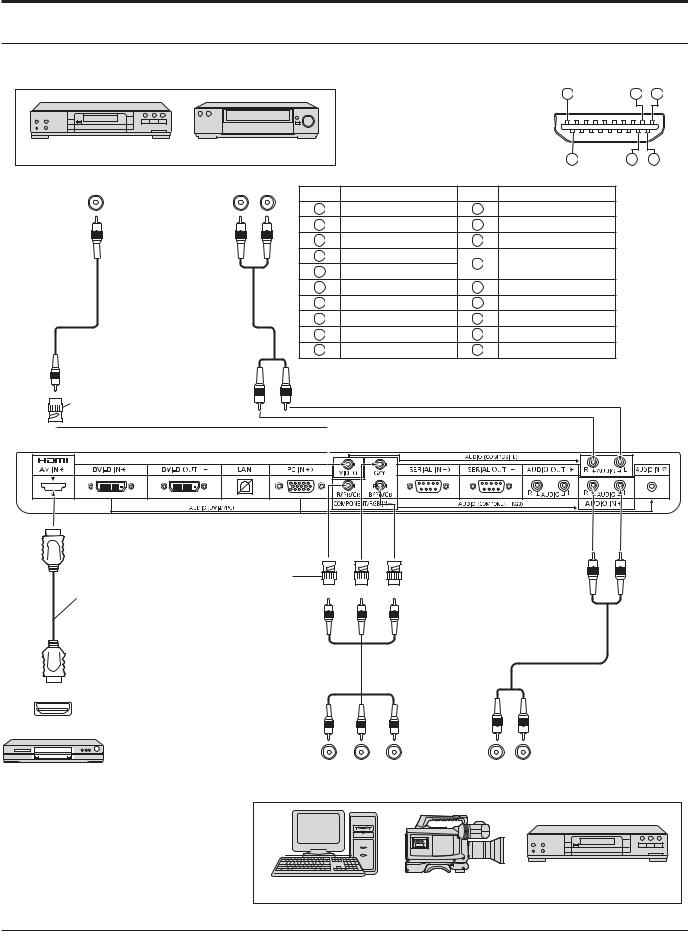
Connections
VIDEO, COMPONENT / RGB IN and HDMI connection
Note:
Additional equipment, cables and adapter plugs shown are not supplied with this set.
|
|
19 |
3 |
1 |
DVD Player |
VCR |
18 |
4 |
2 |
|
|
|||
VIDEO OUT |
AUDIO OUT |
[Pin assignments and signal names for HDMI terminal] |
|
|
L |
R |
Pin No. |
Signal Name |
Pin No. |
Signal Name |
|
|
||||
|
|
1 |
T.M.D.S Data2+ |
11 |
T.M.D.S Clock Shield |
|
|
2 |
T.M.D.S Data2 Shield |
12 |
T.M.D.S Clock- |
|
|
3 |
T.M.D.S Data2- |
13 |
CEC |
|
|
4 |
T.M.D.S Data1+ |
14 |
Reserved |
|
|
5 |
T.M.D.S Data1 Shield |
(N.C. on device) |
|
|
|
|
|||
|
|
6 |
T.M.D.S Data1- |
15 |
SCL |
|
|
7 |
T.M.D.S Data0+ |
16 |
SDA |
|
|
8 |
T.M.D.S Data0 Shield |
17 |
DDC/CEC Ground |
|
|
9 |
T.M.D.S Data0- |
18 |
+5V Power |
|
|
10 |
T.M.D.S Clock+ |
19 |
Hot Plug Detect |
RCA-BNC
Adapter plug
HDMI cables
HDMI
AV OUT
RCA-BNC |
Adapter plug
DVD Player
Notes:
•Change the “COMPONENT/RGB-IN SELECT” setting in the “SETUP” menu to “COMPONENT” (when COMPONENT signal connection) or “RGB” (when RGB signal connection). (see page 40)
•Accepts only RGB signals from COMPONENT/RGB IN terminal with “SYNC ON G”.
Y PB PR OUT |
L |
R |
RGB OUT |
AUDIO OUT |
|
Computer |
RGB Camcorder |
DVD Player |
12
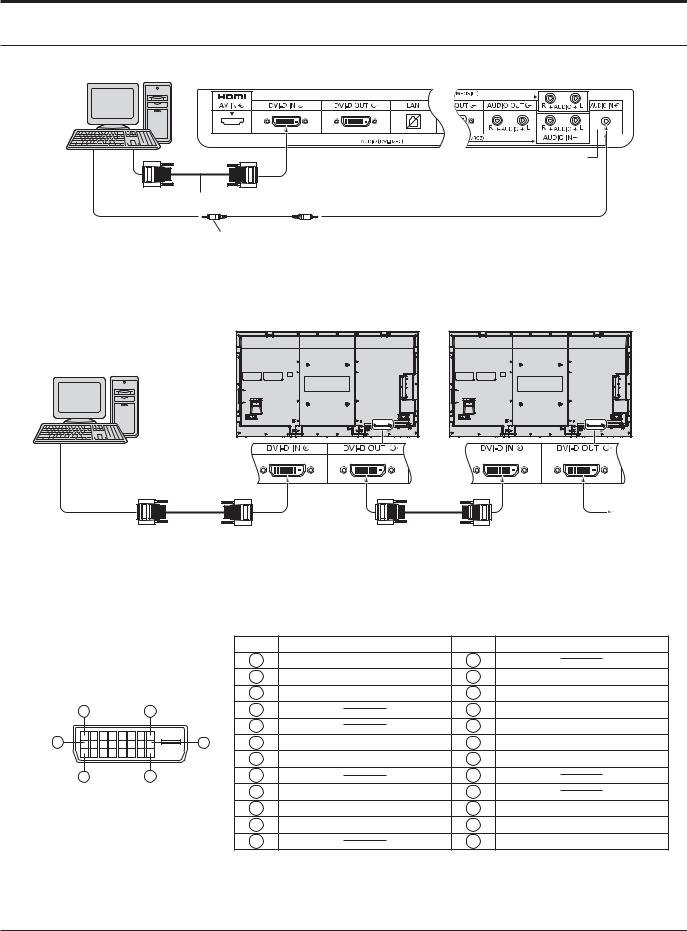
Connections
DVI-D IN, DVI-D OUT connection
PC with DVI-D video out
Shared with PC IN.
DVI-video cable (Within 5 m)
|
Stereo mini plug (M3) |
|
Daisy chain connection |
|
|
When using the multi display, multiple LCD Displays can be daisy chained. |
|
|
PC with DVI-D |
First LCD Display |
Second LCD Display |
|
|
|
video out
|
|
Third and |
|
* |
* |
subsequent |
|
LCD |
|||
* DVI-video cable |
|
Displays
•Up to 10 displays can be connected with a daisy chain, but the number of the connected displays may be limited by a cable, signal or equipment to use.
•HDCP signals can be processed, with up to 8 displays connected via a daisy chain connection.
DVI-D Input/Output Connector |
Pin No. |
Signal Name |
Pin No. |
Signal Name |
||
Pin Layouts |
|
1 |
T.M.D.S. data 2- |
13 |
|
|
|
|
2 |
T.M.D.S. data 2+ |
14 |
+5 V DC |
|
|
|
3 |
T.M.D.S. data 2 shield |
15 |
Ground |
|
1 |
8 |
4 |
|
16 |
Hot plug detect |
|
|
|
5 |
|
17 |
T.M.D.S. data 0- |
|
9 |
16 |
6 |
DDC clock |
18 |
T.M.D.S. data 0+ |
|
|
|
7 |
DDC data |
19 |
T.M.D.S. data 0 shield |
|
17 |
24 |
8 |
T.M.D.S. data 1- |
20 |
|
|
Connection port view |
9 |
21 |
|
|||
10 |
T.M.D.S. data 1+ |
22 |
T.M.D.S. clock shield |
|||
|
|
|||||
|
|
11 |
T.M.D.S. data 1 shield |
23 |
T.M.D.S. clock+ |
|
|
|
12 |
|
24 |
T.M.D.S. clock- |
|
Note:
• Additional equipment and cables shown are not supplied with this set.
13
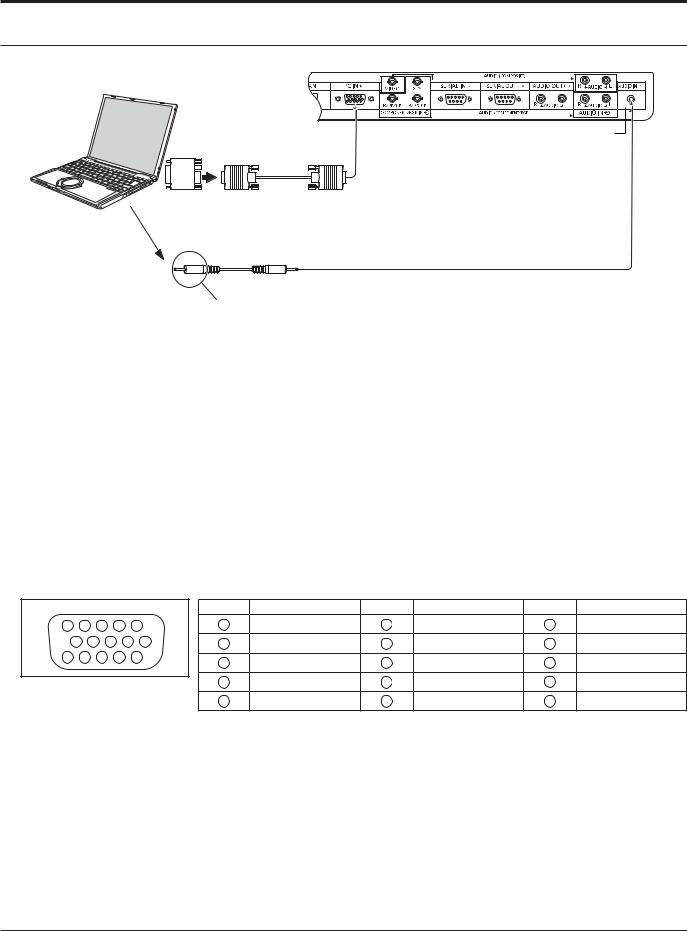
Connections
PC Input Terminals connection
(Female)
COMPUTER
Conversion adapter Shared with DVI-D IN.
(if necessary) |
(Male) |
|
RGB |
|
Mini D-sub 15p |
Audio
Stereo mini plug (M3)
Connect a cable which matches
the audio output terminal on the computer.
Notes:
•Computer signals which can be input are those with a horizontal scanning frequency of 30 to 110 kHz and vertical scanning frequency of 48 to 120 Hz. (However, the image will not be displayed properly if the signals exceed 1,200 lines.)
•The display resolution is a maximum of 1,440 × 1,080 dots when the aspect mode is set to “4:3”, and 1,920 × 1,080 dots when the aspect mode is set to “FULL”. If the display resolution exceeds these maximums, it may not be possible to showne detail with suf cient clarity.
•The PC input terminals are DDC2B-compatible. If the computer being connected is not DDC2B-compatible, you will need to make setting changes to the computer at the time of connection.
•Some PC models cannot be connected to the set.
•There is no need to use an adapter for computers with DOS/V compatible Mini D-sub 15P terminal.
•The computer shown in the illustration is for example purposes only.
•Additional equipment and cables shown are not supplied with this set.
•Do not set the horizontal and vertical scanning frequencies for PC signals which are above or below the speci ed frequency range.
Signal Names for Mini D-sub 15P Connector
5 4 3 2 1
10 |
9 |
8 |
7 |
6 |
|
15 |
14 |
13 |
12 |
|
11 |
Pin Layout for PC Input Terminal
Pin No. |
Signal Name |
Pin No. |
Signal Name |
Pin No. |
Signal Name |
1 |
R |
6 |
GND (Ground) |
11 |
NC (not connected) |
2 |
G |
7 |
GND (Ground) |
12 |
SDA |
3 |
B |
8 |
GND (Ground) |
13 |
HD/SYNC |
4 |
NC (not connected) |
9 |
+5 V DC |
14 |
VD |
5 |
GND (Ground) |
10 |
GND (Ground) |
15 |
SCL |
14

Connections
SERIAL Terminals connection
The SERIAL terminal is used when the Display is controlled by a computer.
Note: To use serial control for this unit, make sure to set the “CONTROL I/F SELECT” in the “NETWORK SETUP” menu to “RS-232C”. (see page 45)
COMPUTER 
RS-232C Straight cable
(Male)
(Female)
D-sub 9p
In addition, a particular LCD Display can be controlled with a PC while several LCD Displays are daisy chained.
COMPUTER
(Female)
*
D-sub 9p
First LCD Display |
Second LCD Display |
(Male) |
(Male) |
(Female) (Female) |
(Female) (Female) |
Third LCD Display |
|
|
|
* |
* |
(Male) |
* RS-232C Straight cable
Notes:
•Use the RS-232C straight cable to connect the computer to the Display.
•The computer shown is for example purposes only.
•Additional equipment and cables shown are not supplied with this set.
•When using daisy chain, set “Serial Daisy Chain” in the Options menu. (see page 47)
•For daisy chain connection, use a straight cable connected to pins numbered 2 through 8 .
The SERIAL terminal conforms to the RS-232C interface speci cation, so that the Display can be controlled by a computer which is connected to this terminal.
The computer will require software which allows the sending and receiving of control data which satis es the conditions given below. Use a computer application such as programming language software. Refer to the documentation for the computer application for details.
Communication parameters
Signal level |
RS-232C compliant |
Synchronization method |
Asynchronous |
Baud rate |
9600 bps |
Parity |
None |
Character length |
8 bits |
Stop bit |
1 bit |
Flow control |
- |
1 2 3 4 5
6 7 8 9
Pin layout for SERIAL Terminal
Signal names for SERIAL IN terminal
Pin No. |
Details |
2 |
R X D |
3 |
T X D |
4 |
DTR |
5 |
GND |
6 |
DSR |
7
8(Shorted in this set)
1 • 9 |
NC |
These signal names are those of computer speci cations.
15

Connections
Basic format for control data
The transmission of control data from the computer starts with a STX signal, followed by the command, the parameters, and lastly an ETX signal in that order. If there are no parameters, then the parameter signal does not need to be sent.
STX 

 C1 C2 C3
C1 C2 C3
 :
: 


 P1 P2 P3 P4 P5
P1 P2 P3 P4 P5 

 ETX
ETX
|
|
|
|
Colon |
|
Parameter(s) |
|
End |
|
|
|
|
|
|
|||
Start |
|
3-character |
(1 - 5 bytes) |
|
(03h) |
|||
|
||||||||
(02h) |
|
command (3 bytes) |
|
|
|
|||
Notes:
•If multiple commands are transmitted, be sure to wait for the response for the rst command to come from this unit before sending the next command.
•If an incorrect command is sent by mistake, this unit will send an “ER401” command back to the computer.
•Consult anAuthorized Service Center for detail instructions on command usage.
•S1A and S1B of Command IMS are available only when a dual input terminal board is attached.
Command
Command |
Parameter |
Control details |
PON |
None |
Power ON |
POF |
None |
Power OFF |
AVL |
*** |
Volume 000 - 100 |
AMT |
0 |
Audio MUTE OFF |
|
1 |
Audio MUTE ON |
IMS |
None |
Input select (toggle) |
|
SL1 |
SLOT input (SLOT INPUT) |
|
S1A |
SLOT input (SLOT INPUT A) |
|
S1B |
SLOT input (SLOT INPUT B) |
|
AV1 |
VIDEO input (VIDEO) |
|
AV2 |
COMPONENT/RGB IN input |
|
HM1 |
(Component) |
|
HDMI input (HDMI) |
|
|
DV1 |
DVI-D IN input (DVI) |
|
PC1 |
PC IN input (PC) |
DAM |
None |
Screen mode select (toggle) |
|
ZOOM |
ZOOM1 |
|
FULL |
FULL |
|
NORM |
4:3 |
|
ZOM2 |
ZOOM2 |
With the power off, this display responds to PON command only.
16
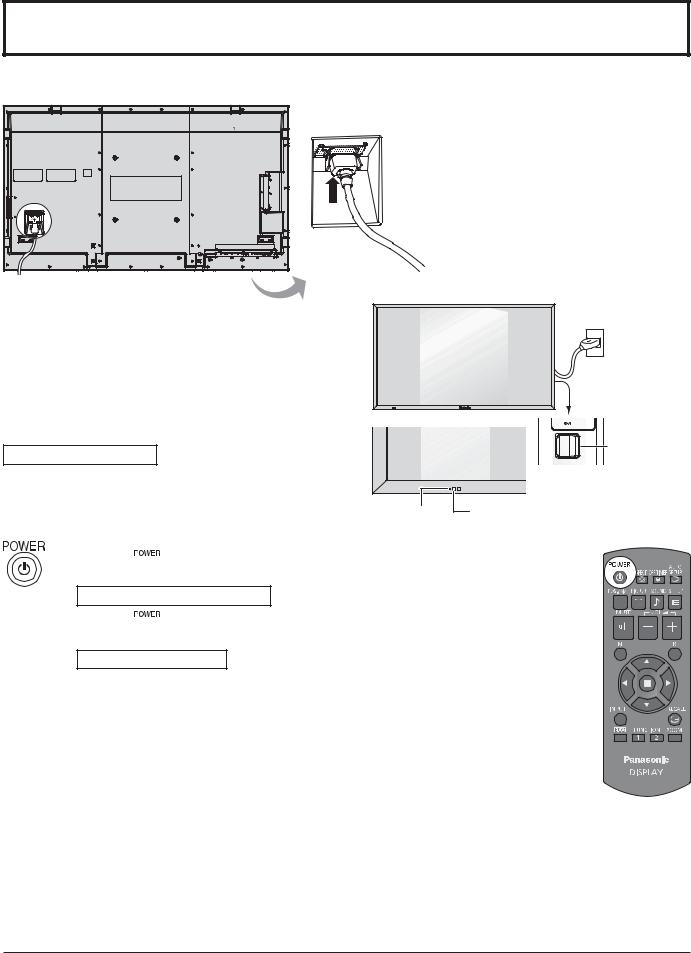
Power ON / OFF
Connecting the AC cord plug to the Display.
Connecting the plug to the Wall Outlet. |
|
|
Note: |
|
|
When disconnecting the AC cord, be absolutely sure to |
|
|
disconnect the AC cord plug at the socket outlet rst. |
|
|
Press the Power switch on the Display to turn the set on: |
|
|
Power-On. |
Power switch |
|
Power Indicator: Green |
||
|
||
Power Indicator |
Remote Control Sensor |
Press the  button on the remote control to turn the Display off.
button on the remote control to turn the Display off.
Power Indicator: Red (standby)
Press the  button on the remote control to turn the Display on.
button on the remote control to turn the Display on.
Power Indicator: Green
Turn the power to the Display off by pressing the 
 switch on the unit, when the
switch on the unit, when the
Display is on or in standby mode.
Note:
During operation of the power management function, the power indicator turns orange in the power off state.
17
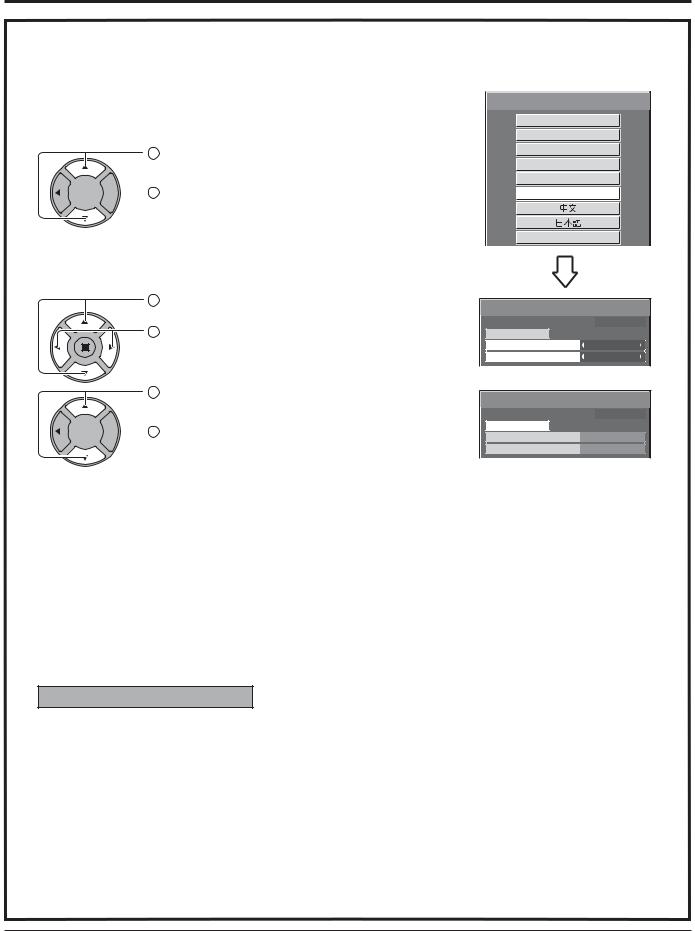
Power ON / OFF
When rst switching on the unit
Following screen will be displayed when the unit is turned on for the rst time. Select the items with the remote control. Unit buttons are invalid.
OSD LANGUAGE
1 Select the language.

 2 Set.
2 Set.
PRESENT TIME SETUP
 OSD LANGUAGE
OSD LANGUAGE
English (UK)
Deutsch
Français
Italiano
Español
ENGLISH (US)
1 |
Select “DAY” or “PRESENT TIME OF DAY”. |
PRESENT TIME SETUP |
|
|
|
|
|
2 |
Setup “DAY” or “PRESENT TIME OF DAY”. |
PRESENT TIME OF DAY |
MON 99 : 99 |
SET |
MON |
||
|
|
DAY |
|
|
|
PRESENT TIME OF DAY |
99 : 99 |
1 Select “SET”.

 2 Set.
2 Set.
PRESENT TIME SETUP |
|
PRESENT TIME OF DAY |
MON 99 : 99 |
SET |
TUE |
DAY |
|
PRESENT TIME OF DAY |
10 : 00 |
Notes:
•Once the items are set, the screens won't be displayed when switching on the unit next time.
•After the setting, the items can be changed in the following menus. OSD LANGUAGE (see page 37)
PRESENT TIME SETUP (see page 30)
Power ON warning message
The following message may be displayed when turning the unit power ON:
No activity power off Precautions
’NO ACTIVITY POWER OFF’ IS ENABLED.
If “NO ACTIVITY POWER OFF” in SET UP menu is set to “ENABLE”, a warning message is displayed every time the power is turned ON. (see page 34)
This message display can be set with the following menu: Options menu
Power On Message (see page 48)
18
